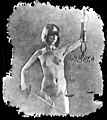Light-and-shade watermark
Watermarking technique

A light-and-shade watermark,[note 1] is a watermark image produced in a chiaroscuro style. In a traditional watermark, an image is produced in paper fibers by contrasting shades of light and dark in places where the paper is made thinner or thicker during the printing process. The resulting image has a high-contrast "black and white" quality with no graduated shading in between. In a chiaroscuro watermark, however, the fibers in the paper run from thin to thick, producing an image with many shades from light to dark.[1][2] The technique was first developed in 1848 by William Henry Smith as a method to help prevent counterfeiting.[3]
Gallery
- Portrait of Dard Hunter, well-known book maker, 1920s
-
 Image of a woman using a chiaroscuro watermark
Image of a woman using a chiaroscuro watermark -
 Nude woman depicted in chiaroscuro watermark
Nude woman depicted in chiaroscuro watermark -
 Chiaroscuro watermark by the Italian papermaker C.M. Fabriano
Chiaroscuro watermark by the Italian papermaker C.M. Fabriano
Notes
- ^ Also called a chiaroscuro watermark, a tonal, shaded, or shade-craft watermark, or a shadowmark
References
- ^ Samson, Linda (1993). "Cartiere Enrico Magnani". Hand Papermaking. 9 (1): 9.
- ^ Sidney E. Berger (2016-10-17). The Dictionary of the Book: A Glossary for Book Collectors, Booksellers, Librarians, and Others. Rowman & Littlefield. p. 145. ISBN 978-1-4422-6340-6.
- ^ "Chiaroscuro Watermarks". Industrial Design. 5: 57. 1958.












